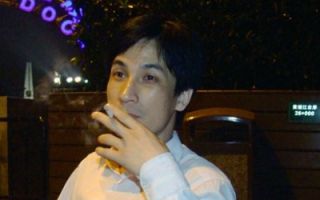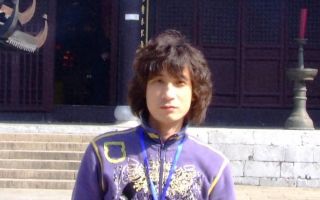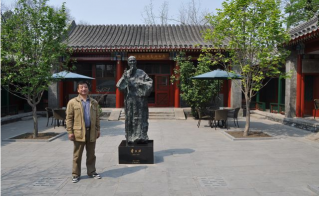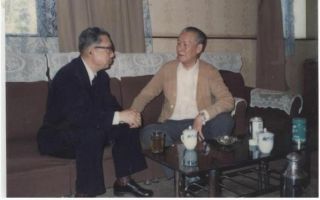《大器晚成的齐白石》
- 2021-08-30 11:31:37
- 点赞量:6545
- 点击量:97102
- 作者:郝连成 Hao Liancheng

齐白石在北京有好几处故居。像西城区的跨车胡同,锣鼓巷雨儿胡同等。我去的是东城区的雨儿胡同13号院。
Qiboshi has several former residences in Beijing. Such as the cross car alley in Xicheng District, Luogu lane, Yuer alley, etc. I went to yard 13, Yuer Hutong, Dongcheng District.
资料说:该宅院建于清代中晚期,13号院仅为原宅院的一部分,是较完整的单体四合院。坐北朝南,大门一间(不是原来的大门),倒座房两间。院内南、北、东、西各有三间房屋,均为硬山顶合瓦过垄脊屋面,前出廊子。廊步明间有雀替,尽间上有倒挂楣子,下有坐凳栏杆。 房子之间由转角廊相连。北房带东西耳房各三间,南房西接顺山倒座房三间。各房墀头处均有精美的砖雕图案,各廊间的走马板处有书法篆刻砖雕,北房明间木隔扇上有木刻楹联。正房紫檐下嵌着“齐怕石旧居纪念馆”馆名,落款为王明明。问馆内服务员得知王明明为北京市文联主席。
According to the data, the house was built in the middle and late Qing Dynasty. House 13 is only a part of the original house, which is a relatively complete single quadrangle. North facing south, one gate (not the original gate) and two reverse rooms. There are three houses in the south, north, East and west of the hospital, all of which are hard peak, combined tile, ridge roof and porch. There are sparrows in the corridor, with upside down lintels on the top and stool railings under the bottom. The houses are connected by a corner gallery. The north room has three East and West ear rooms, and the south room is connected with three shunshan daozuo rooms in the West. There are exquisite brick carvings at the head of each room, calligraphy and seal cutting brick carvings at the horse walking board between corridors, and wooden couplets on the wooden partition fan in the north room. Under the purple eaves of the main house is embedded the name of "qibashi Old Residence Memorial Hall", which is signed by Wang Mingming. Ask the staff in the museum that Wang Mingming is the chairman of Beijing Federation of literary and art circles.
从1955年周恩来总理批准由政府出资为齐白石在这里购买的一-处四合院,到1957年9月16日去世,齐白石老人在这里生活了近3年的时间。据陈列馆的服务员讲,现在里边的家具除正房里的画案是当年齐白石使用过的实物外,其他的床、条案、圈椅等都是后配置的,虽然不是齐白石用过的原物件,但也透有百八十年的气息。
Qi Baishi lived here for nearly three years since Premier Zhou Enlai approved the purchase of a - Courtyard by the government for Qi Baishi in 1955 and died on September 16, 1957. According to the attendants of the exhibition hall, except that the painting case in the main room is the real object used by Qi Baishi, the other beds, tables and armchairs are post configured, although not Qi Baishi It's a used original, but it also has a smell of 180 years.
正是在这样气息的笼罩中我走近了这位有些传奇的世纪老人。
It was in this atmosphere that I approached the legendary century old man.
感慨之一:自学成材当教授。
One of my regrets: become a professor by self-study.
齐舶石曾在70岁时写过一首《往事示儿辈》诗:
At the age of 70, Qi Boshi wrote a poem "the past shows his children's generation":
村书无角宿缘迟
Village book has no corner and fate is late
廿七年华始有师
A teacher begins in twenty-seven years
灯盏无油何害事
What's wrong with lamps without oil
自烧松火读唐诗。
Read Tang poetry by burning pine fire.

齐白石老人本名叫齐纯芝,后改名为齐璜,字濒生,白石山人。小时候家里穷,15岁时开始学习雕花木匠,27岁时开始学习画画。
Qi Baishi's real name was Qi Chunzhi, and later he was renamed Qi Huang. The word is near life. He is from Baishi mountain. When I was a child, my family was poor. I began to learn carving carpenter at the age of 15 and painting at the age of 27.
说起齐白石在画上的出名还应得益于日本人对他作品的认可。
Speaking of Qi Baishi's fame in painting, we should also benefit from the recognition of his works by the Japanese.
1919年定居北京后,齐老开始了他的艺术创作,可是,他的画风独特,并未被大多数人所接受,又由于他是木匠出身,所以他的画很少有人赏识,他的作品在琉璃厂南纸店卖的并不好,生活很窘困。后来,另一位国画大师陈师曾在日本举行画展,同时也展出了几幅齐白石的画,没想到,齐舶石的大写意红花墨叶、山水、花鸟受到了高度的赞扬和追捧,许多美术史家称赞中国的绘画进入了新的高度。白石的画也就此名扬海外。再后来,许多欧洲人到琉璃厂点名要齐白石的画,南纸店老板把齐老的画提价几倍、几十倍,仍然供不应求。白石的画得益于日本艺术界,在日本的绘画界很有名气,很多日本友人特此常来拜访。而此时日本人已侵占了中国的大半个江山,中国正在人不分老幼地不分南北的全民抗战时期,所以齐白石坚决不卖画给日本人。并在他创作的《鸬鹚图》题诗:
After settling in Beijing in 1919, Mr. Qi began his artistic creation. However, his painting style was unique and was not accepted by most people. Because he was a carpenter, few people appreciated his paintings. His works did not sell well in Liulichang South paper shop and his life was very difficult. Later, another master of traditional Chinese painting, Chen Shi, held a painting exhibition in Japan and also exhibited several Qi Baishi paintings. I didn't think so By, the freehand brushwork of Qibo stone, red flowers and ink leaves, landscape, flowers and birds were highly praised and sought after, and many art historians praised that Chinese painting had entered a new height. The painting of ship stone is also famous overseas. Later, many Europeans went to Liulichang to ask for Qi Baishi's paintings. The owner of the South paper shop raised the price of Qi Lao's paintings several times or dozens of times, but the supply still fell short of demand. Platinum stone's paintings benefit from the Japanese art world. They are very famous in the Japanese painting world. Many Japanese friends hereby often visit them. At this time, the Japanese have occupied more than half of China. China is in the period of national anti Japanese War, regardless of age, North and south, so Qi Baishi resolutely does not sell paintings to the Japanese. He also wrote a poem in his picture of cormorants:
大好江山破碎时,
When great rivers and mountains break,
鸬鹚一饱别无知。
Don't be ignorant when cormorants are full.
渔人不识兴亡事,
Fishermen don't know the rise and fall,
醉把扁舟系柳枝。
Drunk tied the boat to a willow branch.
1927年,北平艺术专科学校校长请齐白石任中国画教授。解放后的头衔更多:曾任北京国立艺专教授、中央美术学院名誉教授、北京画院名誉院长、中国美术家协会主席。文化部于1953年授予“人民艺术家”称号,1955年又荣获国际和平奖金,1963年被列为世界文化名人。
In 1927, the president of Beiping Art College invited Qi Baishi to be a professor of Chinese painting. After liberation, he has more Titles: he once served as a professor of Beijing National Academy of art, an honorary professor of the Central Academy of fine arts, an honorary president of Beijing Academy of painting, and President of China Artists Association. The Ministry of culture awarded the title of "people's artist" in 1953, won the international peace prize in 1955, and was listed as a world cultural celebrity in 1963.

取得如此成就而没正儿八经地念过大学,用现在的流行话来说齐白石靠的是自学成才。
Qi Baishi made such achievements without seriously going to college. In the current popular saying, Qi Baishi relied on self-study.
感慨之二: 40岁时开始“五出五归”
Emotion 2: at the age of 40, the "five out and five return"
白石全然不顾孔老圣人“四十而不惑”的古训,向中国文人的技能领域全面进军,而最终成为-代大师。出版有《齐白石画集》、《齐白石作品集》 、《白石诗草》 、《白石印草》 、《齐白石作品选集》等可见大器晚成。
ship stone completely ignored the ancient motto of old Kong sage "40 but not confused", entered the skill field of Chinese literati in an all-round way, and finally became a master of the - generation. It has published Qi Baishi's paintings, Qi Baishi's works, Baishi's poems, Baishi's prints, and Qi Baishi's works.
而此段时间的五次离家游学访师,是他全面学成绘畫篆刻诗文的关键时期。此时他完全背离了孔子“四十而不惑”,和“父母在不远游”的古训,远离家乡,走出了湖南湘潭大山第一-次主要是去西安,后绕到北京、天津走了一大圈,结识了樊樊山。二出二归主要去南昌,王门三匠在南昌。王湘绮有三个弟子,一个齐白石,是木匠。一个是铜匠,还有一个是镍匠,都是平民出身的艺术家。
During this period, he left home to study and visit teachers for five times, which was a key period for him to fully learn painting, seal cutting and poetry. At this time, he completely deviated from Confucius' ancient motto of "forty without confusion" and "parents don't travel far". He was far away from his hometown and went out of Xiangtan mountain in Hunan. The first time he mainly went to Xi'an, then went around Beijing and Tianjin and got to know Fanshan. Two out and two return mainly go to Nanchang, and the three Royal craftsmen are in Nanchang. Wang Xiangqi has three disciples, Qi Baishi, a carpenter. One is a copper craftsman and the other is a nickel craftsman. They are all artists of civilian origin.
五出五归用了八年时间,行万里路。这个时候齐白石觉得自己需要静下来,他幽居故乡,又用了八年时间读万卷书。从此奠定了齐拍石的诗文基础,形成了自已的独特绘画风格。
It took eight years to travel thousands of miles. At this time, Qi Baishi felt that he needed to calm down. He lived in seclusion in his hometown and spent eight years reading thousands of books. Since then, it has laid the poetic foundation of Qi Paishi and formed its own unique painting style.
感慨之三:文从风汽节高
Emotion 3: Wen Cong Feng Qi Jie Gao dared
除前边提到的对日本人的态度外,对日伪汉奸也敢信笔奚落。抗日战争时期,北平伪警司令、大特务头子宣铁吾过生日,硬邀请国画大师齐白石赴宴作画。齐白石来到宴会上,环顾了一下满堂宾客,略为思索,铺纸挥洒。转眼之间,一只水墨螃蟹跃然纸上。众人赞不绝口, 宣铁吾喜形于色。不料,齐白石笔锋轻轻一挥,在画上题了一行字:“横行到几时”,后书“铁吾将军”然后仰头拂袖而去。
To belittle the Japanese puppet traitors in addition to the above-mentioned attitude towards the Japanese. During the war of resistance against Japan, Xuan tiewu, commander of the puppet police and chief spy of Peiping, had a birthday and forced Qi Baishi, a master of traditional Chinese painting, to dinner and paint. Qi Boshi came to the banquet and looked around The whole hall was full of guests, thinking a little, spreading paper and sprinkling. In the twinkling of an eye, an ink crab jumped onto the paper. The crowd was full of praise, and Xuan tiewu was very happy. Unexpectedly, Qi Bo's stone brush gently waved, wrote a line of words on the painting: "how long will it go sideways", then wrote "general tie Wu", and then looked up and brushed away.
一个汉奸求画,齐白石画了一个涂着白鼻子,头戴乌纱帽的不倒翁,还题了一首诗:
A traitor asked for a painting. Qi Boshi painted a tumbler with a white nose and a black hat, and wrote a poem:
乌纱白扇俨然官,
The black gauze white fan looks like an official,
不倒原来泥半团,
If you don't pour half the mud,
将妆忽然来打破,
Break the makeup suddenly,
浑身何处有心肝.?
Where do you have a heart?
至此想到了我前些年曾写过的一首《咏虾》:
At this point, I thought of a song "chanting shrimp" I wrote a few years ago:
龙宫殿前曾当值
Once on duty in front of the Dragon Palace
也有耀武扬威时
There are also times when people are swaggering
今为人间一道菜
This is a dish on earth
只怪天生腰不直。
It's just that you're not straight.
要是配到齐白石的《虾图》上,也当是幅佳作。
If it is matched with Qi Baishi's shrimp picture, it should also be a good work.
图
chart
感慨之四:名人的辉煌凡人的情怀
Emotion 4: the brilliance of celebrities and the feelings of mortals

最后这点感慨是从上边这幅画的题字中感觉到的。看画中的题字,可推测是一个叫次溪的晚辈熟人在一个叫沂文斋的地方得到了白石先生的这幅画作,求其题字。于是齐白石给题下了如下内容:甲成:
次溪世娃于文沂斋得之,求余题记,已未至今忽二十又六年矣,手迹犹新,鬓毛非蓓,再十六年余骨何在谁可知也。次溪爱吾手迹犹爱吾骨否。蓓端午前十日白石。
Finally, this feeling is felt from the inscription of the picture above. Looking at the inscription in the painting, it can be inferred that a younger acquaintance named Cixi got Mr. Baishi's painting at a place called yiwenzhai and asked for the inscription. So Qi Baishi wrote the following: Jiacheng: Cixi Shiwa got it in Wenyi Zhai and asked for more inscriptions. It has not been 20 and 6 years now. The handwriting is still new, and the temples are not buds. Who knows where the bones are in the next 16 years. Cixi loves my handwriting as much as my bones. Bei Baishi ten days before the Dragon Boat Festival.
从此题字中可看出齐白石也和常人一样,对人生有种留恋的感慨。看到他这段话,使我一下想起了书圣王羲之《兰亭序》里的话来。王王羲之在文中记完当天与朋友们的游乐过程后笔锋一转也是发出对人生的感叹,他写道:
向之所欣,俯仰之间,已为陈迹,犹不能不以之兴怀。况修短随化,终期于尽。古人云:“死生亦大矣。”岂不痛哉!每览昔人兴感之由,若合一契,未尝不临文嗟悼,不能喻之于怀。固知一死生为虚诞,齐彭殇为妄作。后之视今,亦犹今之视昔。悲夫!故列叙时人,录其所述,虽世殊事异,所以兴怀,其致一也。后之览者,亦将有感于斯文。
From this inscription, it can be seen that Qi Baishi, like ordinary people, has a feeling of nostalgia for life. Seeing his words reminded me of the words in the preface to Lanting by Wang Xizhi, the sage of calligraphy. After Wang Xizhi wrote down the fun with his friends on that day, he also sighed about life. He wrote: it is an old story to be happy with it and look down on it, so we can't help but be happy with it. Kuang Xiu The short period changes with the end period. The ancients said, "death and life are also great." It hurts! Every time we look at the reasons for people's happiness in the past, if we have a contract, we will mourn in the text, which can not be compared to our hearts. A solid knowledge of life and death is a false birth, and Qi Pengshang is a false work. The future looks at the present and the past. Sad husband! Therefore, the people of the time are listed and recorded. Although there are different things in the world, they are happy and bring about one. Later visitors will also feel gentle.
不知齐白石题字之时脑子里是不是也闪过了《兰亭序》的此段议论。
I wonder if Qi Baishi also flashed this paragraph of the preface to Lanting when he wrote the inscription.










0 条 评 论 Write a Response